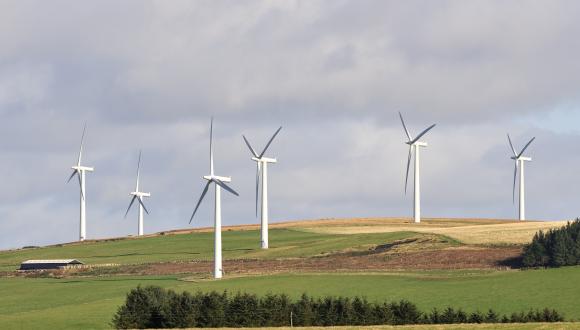Environmental Statements and Annexes of Environmentally Sensitive Bird Information
Published: 2016
Introduction
- Environmental statements prepared to support planning applications often need to incorporate environmentally sensitive information in the document. Releasing this information publicly could have unintended consequences and needs to be handled carefully
- This guidance sets out what information we regard as being sensitive, and how that information should be dealt with in environmental statements.
Background
- Environmentally sensitive bird information is information which, if released, could jeopardise the status of a vulnerable species. Important examples of this are where release of that information may make it easier for an individual to take, kill, injure or disturb a bird, usually when occupying a nest site, when caring for dependent young or when occupying a communal winter roost. Some species may also be vulnerable because releasing localities could increase unintentional disturbance (e.g. people wishing to view capercaillie lek[1] sites).
- All birds are protected by law, although derogations allow some to be taken or killed under licence. Species using nest sites that are occupied consistently from one year to the next, or those using nest sites that are easy to define on the basis of habitat type are particularly vulnerable. The same may also apply to the leks of species such as capercaillie and to some species that roost consistently in certain locations in autumn and winter.
- Some birds are legally protected from disturbance during the breeding seasons as they are particularly vulnerable to egg collectors, illegal persecution or disturbance-related impacts. Information that identifies breeding locations for these species is therefore considered environmentally sensitive. Flight-line maps using vantage point watches that identify nest locations may also include sensitive information.
- Records of birds in flight, wintering records or casual sightings are unlikely to constitute sensitive information, except when such information gives a strong indication of breeding. However, it is important to note that winter records of species that hold territories all year round (some birds of prey) as well as winter roost sites for species such as harriers is also environmentally sensitive.
- Birds on Schedule 1 of the Wildlife & Countryside Act (1981), as amended by the Nature Conservation (Scotland) Act 2004, and species on Annex I of the EU Birds Directive fall into the category of having potentially sensitive data. A list of these is available.
Environmentally sensitive bird information and the law
- There is a general presumption in favour of full disclosure (Regulation 10(2)(b) in the Environmental Information (Scotland) Regulations 2004). However, Regulation 10(5)(g) allows environmentally sensitive information to be withheld if its release would harm the subject of the information. It is valid to consider whether release of the information is in the wider public interest, and this test will be applied to such a judgement, but we believe that in most cases the risk of harm to sensitive species, as outlined above, justifies the application of Regulation 10(5)(g).
- In these cases we recommend using an Annex of Environmentally Sensitive Information, as set out in Scottish Government guidance on scoping for wind farm developments. It should be noted, however, that any decision to withhold information may be subject to appeal to the Scottish Information Commissioner who could ultimately overturn our advice.
The Annex of Environmentally Sensitive Information[2]
10. Presenting data to a restricted audience is acceptable, but only when the data is sensitive enough to warrant it being withheld. It should not be used to limit proper public scrutiny of a development proposal. The following principles apply when considering such an approach:
- The amount of information in a confidential annex should be kept to an absolute minimum.
- There should be a realistic and reasonable expectation that, if the information in a confidential annex is released widely, then some demonstrable harm may come to the relevant species.
- Information that is not sensitive should not be included in any confidential annex. If such information has to be included to illustrate analysis, it should be reproduced elsewhere in the publicly available environmental statement.
- Analyses that are fundamental to the environmental statement should be placed in the main part of the environmental statement and should disguise nest locations or other sensitive information to avoid its disclosure and any adverse consequences that might arise from disclosure.
- Anyone provided with information by third parties who request nondisclosure should respect that request unless it is manifestly unreasonable. If, however, public disclosure is necessary or reasonable, you should consider whether accepting data from third parties under such restrictive conditions is appropriate.
- Anyone gathering data on protected bird species must do so under an appropriate licence and must make it clear within the environmental statement that such a licence was obtained.
- Restrictions on the grounds of environmental sensitivity must not be used to withhold access to information that is regarded as being commercially confidential[3]. Any information regarded as commercially confidential should be included in a separate Annex of Commercially Confidential Information. Information which is both environmentally and commercially confidential should be included within a clearly delineated section of the most relevant annex.
Use of precise OS grid references (e.g. NZ 452674) and/or names of nest sites or territories will normally be inappropriate for sensitive species in the public document. Where possible such sites should be referred to with a specific reference, such as Site A, with codes cross-referred to the annex. However, even the use of code names may sometimes allow site identification and this should be done carefully.
Dealing with environmentally sensitive information
11. Information that could be considered to be confidential includes:
- Nest sites or breeding locations for Schedule 1 and Annex I species
- Lek sites for capercaillie and ruff
- Brood sites that are occupied consistently from one year to the next (e.g. lochs used by black-throated divers for chick rearing)
- Flight line maps using vantage point watches (for wind farm casework) that identify nest locations
- Locations of autumn and winter roosts (e.g. hen harrier & red kite winter roosts)
Information that is not sensitive
12. It is difficult to be prescriptive about what is not likely to be sensitive but a number of cases have highlighted inappropriate use of confidential annexes. These have included:
- Research reports on flight activity of non-breeding birds of prey
- Mathematical models of population trends
- Maps of registrations of waders on moorland (wader registrations are not the same as nest sites)
- Information on migratory or passage species during spring and autumn
- Nest sites of species that are not specially protected.
Contact for further information
Dr. Andy Douse
Policy & Advice Manager, Ornithology
Tel. 01463 725241
[1] A lek is a site where a number of male birds competitively display and if successful, mate with females that attend lek gatherings.
[2] often referred to as the ‘Confidential Annex’
[3] Any claim of commercial confidentiality should be fully evidenced with details of the commercial interest involved, a description of the actual harm that will occur if the information is released and the commercial implications for the company concerned.





